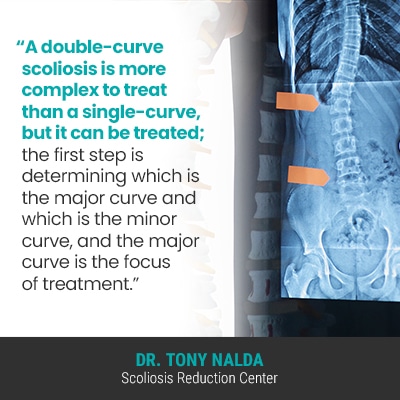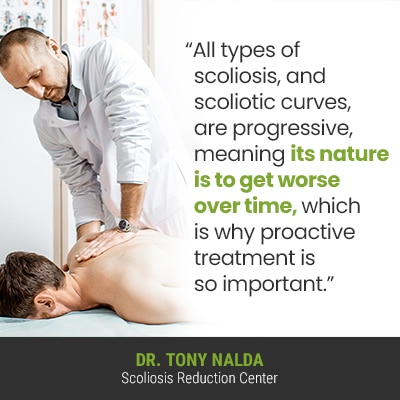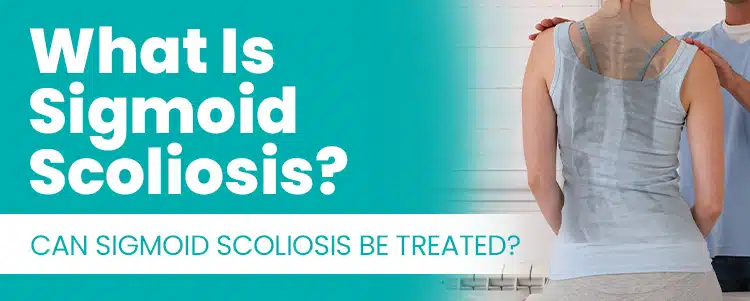It’s not uncommon for conditions to have different names and be referred to in different ways. When it comes to sigmoid scoliosis, we’re talking about cases of scoliosis that involve two unnatural spinal curvatures, rather than one unnatural sideways-bending curve with rotation.
Also known as an s-curve scoliosis and/or a double-curve scoliosis, sigmoid scoliosis means there are two unnatural spinal curves in the spine. Sigmoid scoliosis can be treated, and once the dominant curve is determined, it will be the focus of treatment.
Before getting to the different types of scoliotic curves, let’s start with how scoliosis is diagnosed.
How is Scoliosis Diagnosed?
If a diagnosis of scoliosis is reached, an unnatural sideways spinal curve with rotation has developed, and because of the rotation, scoliosis is a 3-dimensional spinal condition; a scoliotic spine doesn’t just bend unnaturally, but also twists.
I diagnose scoliosis through combinating a physical examination that generally includes an Adam’s forward bend test, taking the patient’s medical and family history, and observing a patient’s posture and gait; I can tell a lot about a person’s spinal health by the way they walk.
With an Adam’s forward bend test, I’m looking at the spine while the patient is bent forward at the hips so the spine, and any rotation and/or postural asymmetries, are highly visible.
If my examination shows indicators for scoliosis, the need for further testing is warranted. I order an X-ray, and through X-ray imaging, I can really see what’s happening in and around the spine.
I can also determine a patient’s Cobb angle measurement during X-ray, and this measurement classifies conditions in terms of severity.
The higher a patient’s Cobb angle, the more out of alignment the spine is, the more severe the condition, and the more noticeable its effects are likely to be:
- Mild scoliosis: Cobb angle measurement of between 10 and 25 degrees
- Moderate scoliosis: Cobb angle measurement of between 25 and 40 degrees
- Severe scoliosis: Cobb angle measurement of 40+ degrees
- Very-severe scoliosis: Cobb angle measurement of 80+ degrees
Part of diagnosing scoliosis involves further classifying it based on key patient/condition variables, and the more specific a diagnosis is, the more customized a treatment plan can be; conditions are classified based on patient age, condition type, severity, and curvature location.
In addition to different condition types, determined by causation, there are also different curvature types that inform the crafting of potentially-effective treatment plans.
What is Sigmoid Scoliosis?
In typical cases of scoliosis, there is a single unnatural sideways spinal curve that bends to the right, away from the heart (dextroscoliosis), but in some atypical cases of scoliosis, a scoliotic curve bends to the left, towards the heart (levoscoliosis), and in some cases, the spine has two unnatural spinal curves that bend in opposite directions.
In cases where a single scoliotic curve bends to the left, this is a red flag for me that there is an underlying pathology causing the scoliosis.
The majority, approximately 80 percent, of known scoliosis cases are classified as idiopathic, meaning not clearly associated with a single-known cause, and the remaining 20 percent are associated with known causes: neuromuscular scoliosis, degenerative scoliosis, and congenital scoliosis.
As sigmoid scoliosis involves more than one spinal section, the rotational component is often more severe, making it more painful, particularly for adults for whom the condition is compressive.

A double-curve scoliosis is more complex to treat than a single-curve, but it can be treated; the first step is determining which is the major curve and which is the minor curve, and the major curve has to be the focus of treatment.
Each curve will be classified individually based on its location and severity, and there are three main spinal sections: the cervical spine (neck), thoracic spine (middle/upper back), and the lumbar spine (lower back).
If a single scoliotic curve develops in the thoracic spinal section, which as the largest section, is the most commonly affected by scoliosis, it would be classified as thoracic scoliosis, but if a double-curve develops in the lower thoracic and upper lumbar spinal sections, this is classified as a an s-shaped thoracolumbar scoliosis.
Curvature location is important because, in general, the area of the body located the closest to the affected spinal section(s) is going to feel the majority of the condition’s direct effects.
For example, a common complication of lumbar scoliosis is sciatic nerve pain because the sciatic nerve starts in the lumbar spine and extends down the back of the lower body, and an unnaturally-curved lumbar spine exposes its surroundings to uneven forces and compression, including nerves and muscles.
How to Treat Sigmoid Scoliosis
All types of scoliosis, and scoliotic curves, are progressive, meaning its nature is to get worse over time, which is why proactive treatment is so important.
Proactive treatment is started as close to the time of diagnosis as possible because this is when a patient’s scoliosis is going to be at its mildest and the most responsive to treatment.
As scoliosis progresses, the spine gets increasingly rigid, and this makes it less responsive to chiropractic care and can also make it difficult for some patients to perform certain therapeutic exercises as part of treatment.
In addition, the more a scoliosis progresses, the more noticeable the condition’s effects are going to be, and when it comes to children, we’re talking about postural deviation, and in adults, the main scoliosis symptom is pain.
When it comes to treating scoliosis, it’s far more effective to proactively work towards preventing progression and increasing condition-effects, than it is to attempt to work towards reversing those effects once they’re established.
Here at the Scoliosis Reduction Center®, I’ve treated all types and severity levels of scoliosis, and our results speak for themselves.

Through a conservative chiropractic-centered treatment approach, I can impact conditions on every level, but as a structural condition, scoliosis has to, first and foremost, be impacted on a structural level through chiropractic care and adjustments.
Once I start to see the major curve reducing, I work towards reducing the minor curve as well, and once curvature reductions are achieved, I can shift the focus to increasing core strength through physical therapy so the spine is optimally supported by its surrounding muscles.
Physical therapy can also help improve posture and address any related muscle imbalance, which is more likely with sigmoid scoliosis because there are two unnatural spinal curves pulling the spine’s surrounding muscles in different directions.
Certain scoliosis-specific exercises can also help activate specific areas of the brain for improved brain-body communication.
Particularly effective on growing spines, corrective bracing can help augment corrective treatment results by pushing the spine into a corrective position, and to meet my patients’ bracing needs, I opt for the ultra-corrective ScoliBrace.
The final and ongoing phase of treatment can include continued chiropractic care and a series of custom-prescribed scoliosis-specific exercises to further stabilize and heal the spine from home.
Conclusion
So what does sigmoid scoliosis mean? It means the spine has developed two unnatural spinal curves that bend in opposite directions.
Cases of sigmoid scoliosis are more complex than typical cases with one unnatural spinal curve.
Diagnosing sigmoid scoliosis, also known as a double-curve scoliosis or an s-curve scoliosis, also involves classifying each curve based on its severity and location.
Double-curves are more complex to treat because there is a major and minor curve, one larger and one smaller, and the larger curve has to be the initial focus of treatment, and as scoliotic spines with two unnatural curves are more rigid than typical condition-types, they tend to be less responsive to treatment.
And as a progressive condition, scoliosis is virtually guaranteed to worsen over time, and this means the unnatural spinal curves are increasing in size, becoming more rigid, and causing more noticeable effects.
In children, the main symptom of scoliosis is postural deviation, and in adults, it’s pain; scoliosis doesn’t become a compressive condition until skeletal maturity has been reached.
Sigmoid scoliosis might be more complex to treat, and while there are never treatment guarantees, it can be highly treatable, particularly when diagnosed early and responded to with a proactive customized conservative treatment plan.
With an integrative approach that combines multiple condition-specific treatment disciplines, sigmoid scoliosis can first be impacted on a structural level by reducing the major curve, and then working to reduce both simultaneously.
Physical therapy, corrective bracing, and rehabilitation are additional facets of treatment that work together to complement chiropractic care and achieve corrective treatment results.




